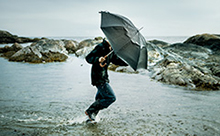Projected impacts for our region

Although we can minimize the impacts of climate change by reducing our greenhouse gas emissions, the climate is already changing and will continue to change. Over the next 50 years, the capital region will see longer, hotter and drier summers, wetter winters and more intense and frequent storms. As a coastal community, scientists also project the capital region will be impacted by sea-level rise.
Understanding climate risks
Without action, these changes threaten a variety of regional and local government services, as well as overall community health and well-being. To better understand the risks of climate change to our region and support planning efforts, the Capital Regional District (CRD) has engaged partners and consultants to model future climate projections related to precipitation and temperature, sea-level rise and coastal flood risk, and vulnerability to extreme heat. Read more >>
By anticipating expected climate impacts and implementing adaptation strategies we can create a more resilient communities. Residents, property owners, businesses, and local governments all play a role in preparing for the impacts of climate change.
Help prepare for climate change
- Learn about our local hazards and what you can do to prepare for extreme weather events. Read more >>
- Get involved in emergency preparedness and response in your community by contacting your local emergency program. Read more >>
- Explore the Extreme Heat Information Portal where you can find maps and information on extreme heat vulnerability in our region. Read more >>
- Install a heat pump to help cool your home, in preparation for longer and hotter summers, taking advantage of rebates and incentives. Read more >>
- Build green infrastructure like rain gardens, green roofs, or living walls. Read more >>
- Increase permeable surfaces on your property to help absorb and slow the flow of storm water. Read more >>
- Conserve water and collect rainwater in preparation for drier, longer summers. Read more >>
- Practice natural gardening to save water and support local biodiversity and native species. Read more >>